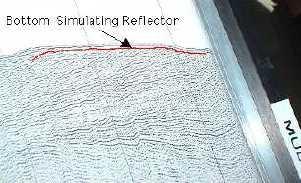9 February, 2004
By 1:52 AM the magnetometer was on deck and the marine techs were
preparing to once again untangle the multichannel streamer from the
gun array. Everything had gone fairly well for the night shift, but
the tangling of the seismic gear was still a problem. The winds had
subsided and the seas were as calm as they had been in days. We were
making a turn to make a connecting line to the next long seismic shot
line. It would be a good time to get what ever needed to be fixed up
on the back deck and make repairs so that everything was ready to go
for the day.
The one of the guns was winched onto the back deck, and the streamer
untangled from the gun array on its own. The marine techs checked
one of the birds and secured the streamer. The pilot brought the
ship to 4 knots and by 2:32 AM all the seismic gear and the
magnetometer were back in the water and we were ready to start taking
data. Just a half hour had passed from when we began to make
repairs. Everything was ready to start firing the guns, but the
scientists and marine techs followed the Marine Mammal Observation
Protocol to the letter. If the seismic equipment is down for more
than twenty minutes we have to start the marine mammal protocol from
the beginning. A sonobuoy was deployed to listen for whale sounds in
the area. A marine mammal observer was on the bridge to make visual
confirmation that there were no mammals in the area. Thirty minutes
later we had the all clear. No whales were seen or heard.
At 3:02 AM the marine and electronics techs started the ramp up
procedure to fire the guns. Since the pressure to the guns had not
been lowered during the untangling of the streamer, we were able to
quickly start firing all four of the guns, and within ten minutes, at
3:11 we were back on the connecting line collecting seismic data.
The seismic equipment continued to work well until about 8:00 AM when
the guns continued to fire, but the data collection system was not
recording the data. With no acquisition, the data from that area is
lost and cannot be recovered, so getting things repaired quickly is
essential. The problem was solved quickly and for the rest of the
day, the seismic worked well. There were no more significant
problems with data, and in the calmer seas, the streamer and the gun
array stayed clear through the remaining course changes.
The data that we have been collecting with the streamer has been very
interesting. We have been able to observe some significant faulting
and today the scientists observed a feature that is called a BSR
(Bottom Simulating Reflector - See photo) The BSR appears as a
distinct feature that runs parallel to the bottom in the seismic
plot. These features are usually formed as the result of chemical
alteration of the rocks in that region.
This BSR could be a Gas Hydrate, sometimes called a Gas Clathrate, or
a Silica Digenetic. The Gas Hydrate is formed from methane gas
entering the spaces in the crystal structure of the rock making up
the crust. This gas may have originally been located well below the
rock that now forms the BSR. The BSR is formed as the gas becomes
contained in the confined spaces of the crystal lattice and causes a
chemical change in the rock.
A Silica Digenetic is the result of water intrusion into the pore
spaces of the rock that causes chemical changes in the structure of
the rock. Both produce nearly identical reflections in the seismic
data. The scientists will review the seismic data further, looking
specifically at how the BSR reflects different frequencies of sound
waves produced by the air guns. This will help to interpret the
structure of the rock in this feature. Future cruises might attempt
to sample the sediments in the area of the BSR to retrieve samples
that could be more definitively analyzed.
In science there are very few absolutes. Questions beg for further
questions. It is a dog chasing its own tail, but this is not an act
of futility. In the process of scientists asking questions they
learn more about the world around us. Scientific discourse and
discussion drive inquiry. The scientists argue their ideas not to be
"right" but to convince themselves and their colleagues that they
have done things thoroughly and appropriately, and that their
analysis can stand the test of time and the review of their peers.
Science is not static. It is amorphous and changing. It is
lightning and rainbows. It is powerful and beautiful.
Thanks to Marcy Davis and Huw Horgan for reviewing the BSR overview.

The seismic plots showing the BSR.

Contact the TEA in the field at
.
If you cannot connect through your browser, copy the
TEA's e-mail address in the "To:" line of
your favorite e-mail package.
|
